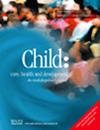Beyond the Label: Antipsychotic Prescribing Practices at a Paediatric Neurodisability Service in Australia
Abstract
Background
The use of antipsychotic medications in children has been increasing in Australia and abroad. Children with complex physical and neurodevelopmental disability remain understudied in the prescribing literature, and we do not have a nuanced understanding of why and to whom antipsychotic medications are prescribed.
Methods
We conducted a retrospective review of records to characterise antipsychotic prescription patterns for children with neurodisability at the Royal Children's Hospital, Melbourne, Australia. We used the Electronic Medical Record to identify children under 19 years, newly prescribed an antipsychotic medication by Department of Neurodevelopment and Disability clinicians between 24/09/2018 and 26/09/2022. We identified 167 encounters for 147 patients, representing 4% (147/3673) of the patients seen in that period. Main outcome measures were the frequency of antipsychotic medication prescription by drug, age category and sex; indication frequency; proportion of off-label use; and frequency and level of psychotropic polypharmacy.
Results
In our cohort, 71% of children had intellectual disability (104/147), 42% autism spectrum disorder (61/147) and 42% cerebral palsy (61/147). Risperidone was the most prescribed antipsychotic medication, in 64% (107/167), followed by olanzapine in 18% (32/167). Off-label prescription was 62% (66/107) for risperidone, 97% (31/32) for olanzapine. The indication for antipsychotic medication was challenging behaviour in 74% (123/167), including aggression in 31% (52/167), agitation in 20% (33/167) and self-injury in 17% (28/167). Nonbehavioural indications included anxiety symptoms in 19% (32/167) and sleep disorders in 14% (24/167). Psychotropic polypharmacy (two or more concurrent psychotropic medications) was present in 78% (130/167), with sedatives (69%, 115/167) and antidepressants (31%, 52/167) most common.
Conclusions
A small proportion of children with neurodisability were prescribed antipsychotic medications, most frequently risperidone for challenging behaviours. Off-label prescription and psychotropic polypharmacy were common. Prescription occurred in a variety of clinical scenarios that sit outside the current field of evidence.


 求助内容:
求助内容: 应助结果提醒方式:
应助结果提醒方式:


